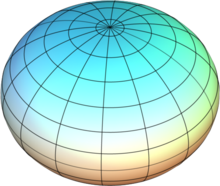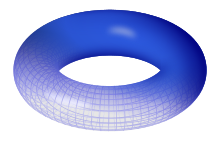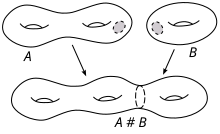Area (math)
A surface in the clear sense is a two-dimensional subset of three-dimensional space , for example a plane , a two-dimensional geometric figure or the boundary surface of a three-dimensional body . A surface can therefore be both flat and curved .
A measure of the size of an area is the area . Colloquially, the area is often referred to as "area". This article is about the mathematical object "area", not area.
The exact definitions of an area differ depending on the sub-area of mathematics . All definitions have in common that the surface is a two-dimensional object.
Elementary geometry
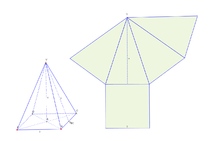
The elementary geometry viewed in the plane , for example, polygons or the inside of a circle , and such objects called surfaces. In three-dimensional space, elementary geometry considers objects such as the cylinder and the cone . These geometric bodies are bounded by surfaces (also called side surfaces ). Together they form the surface of the body. Unfolded or unfolded in one plane, they form the network of the body. In elementary geometry, the concept of area is explained, but not defined in mathematical rigor.
Surfaces in space
Areas described by equations
Many surfaces can be described by equations: The sphere (spherical surface) with center and radius through or the single-shell hyperboloid through . Any such equation can be expressed as a function . Not every such equation describes an area, e.g. B. the solution set consists of the single point .
Let be a smooth function with the property that for every solution of the equation the gradient
is not zero. Then one calls a regular value of , and the quantity a regular area . In the general definition of a regular surface , a neighborhood and a differentiable function must exist for every point , so that a regular value of is and holds.
A surface is called a real algebraic surface if it can be described by a polynomial function . The exact concept of area in real algebraic geometry does not always correspond to the elementary idea: One example is the Whitney umbrella , which, in addition to the area visible in the picture, also includes the axis as a stem, but these two parts cannot be algebraically separated from each other.
Second order surfaces are algebraic surfaces given by a polynomial of degree 2. Examples are the cylinder , which is also examined in elementary geometry and has as a possible equation , or the double cone with an equation . The double cone is not a regular surface, it has a singularity at the zero point .
Areas described by parameterizations
A parameterization of a patch is a smooth immersion defined on a part of the plane . (A mapping is called immersion if the Jacobi matrix of has full rank at every point , or the derivative is injective as the linear mapping it represents.) In the simplest case, the graph can be a function . If you still allow a role change at , then function graphs are sufficient for the local description of any area.
In this context, a regular surface is a subset , so that for each point there is an environment and a parameterization , so that it induces a homeomorphism . This description is equivalent to that given above.
An immersed surface does not mean the obvious weakening of the above definition, but an abstract surface (see below) together with an immersion .
A ruled surface is a surface that parameterizes the shape of an interval
with features . At each base so one is -Straight with the direction attached. (The term “ruled surface” arose from a wrong translation of the English term “ruled surface”: “rule” not only means “rule”, but also “line”.) If it is for everyone and not in the product of and , then it is around an immersed surface. The surface portion of the Whitney umbrella is an immersed ruled surface with the exception of the tip, the single-shell hyperboloid is a regular ruled surface.
A surface of revolution is a surface that is generated by the rotational movement of a function graph around a coordinate axis. If the function is smooth, then the area is obtained by rotating around the -axis
If for all , you get a regular area. Has zeros, it is not an immersed surface.
Differential Geometry of Regular Surfaces
Tangent plane and normal vector
Let be a regular surface and a point . If locally at is given by a regular parameterization with and , then the image of the derivative is a two-dimensional subspace called the tangential plane of in . The tangent plane can be obtained by moving the subspace around the vector . A normal vector is a vector that is orthogonal to the tangent plane.
In the description by local equations, let it be an open subset and a function with a regular value , so that . Then the gradient of is a normal vector at all points of , and the tangent plane can be understood as the plane that is perpendicular to the gradient.
curvature
Let be a regular surface, a point on and a normal vector of length in the point . For a variable tangent vector of length in the point span and an (oriented) plane , and the section is locally a regular curve . Let the curvature of this curve, i.e. That is, if the curve parameterized according to arc length is with , then is . The number is called curvature from towards . If it does not have the same value for all , then there are two mutually orthogonal directions in which the maximum and the minimum assume. and the main curvatures of the point are called , the associated directions main curvature directions. They are used to define the Gaussian curvature and the mean curvature . If you change the direction of the normal vector, the main curvatures change their sign so that the Gaussian curvature remains the same and the mean curvature also changes sign. The sphere with radius has Gaussian curvature and mean curvature (for outward-pointing normal vectors).
If you continue by specifying a function defined for all of the tangential plane , you get a square shape . The corresponding bilinear form is called the second fundamental form and can also be written with the Weingarten mapping , which in turn is the derivation of the normal vector, understood as a Gaussian map . The main curvatures and main directions of curvature are the eigenvalues and eigenvectors of the vineyard mapping, the connection to the first description is made by Sylvester's law of inertia .
Developable surfaces are a class of surfaces with a Gaussian curvature of 0 everywhere. If a surface has 0 Gaussian curvature and no planar points, i. H. no points in which both main curvatures are 0, then it can be developed. Surfaces with Gaussian curvature 0 are locally isometric to the plane, i.e. In other words, they can be mapped onto the plane without any internal shape distortion. Examples are cylinders and cones, in which the mapping into the plane is given by the unwinding of the jacket.
Line of curvature
A regular curve on the surface is called a line of curvature if its tangent direction at every point is a main direction of curvature . Dupin's theorem offers an important aid in determining lines of curvature .
Examples:
- The circles and straight lines lying on a vertical circular cylinder.
- The circles lying on a single-shell rotational hyperboloid and hyperbolas perpendicular to them.
- Circles on a Dupin's cyclide .
Asymptote line
A regular curve on a surface with negative Gaussian curvature (the indicatrix is a hyperbola) is called an asymptote line if its tangent direction at each point has the direction of an asymptote of the indicatrix of the point. So there are two lines of asymptotes at each point. The angle between the two is bisected by the lines of curvature. If a surface contains a straight line, this is an asymptote line. For example, the straight lines on a single-shell hyperboloid are asymptote lines.
Area and minimum areas
The Gram's determinant can be used to define the area of a patch and, more generally, to develop an integration theory for surfaces: If a patch of surface and a function, then the integral of is defined as
For integrals over whole the area may have to be subdivided.
A minimal area is an area that has a locally minimal area, more precisely the parameterization of which is a critical point for the area functional. Such forms take, for example, soap skins when they are stretched over a suitable frame (such as a blow ring). Minimal surfaces are also characterized by the fact that their mean curvature has the value 0 everywhere.
The Gaussian curvature is a measure of the deviation of the local area from the values of the plane: Describes the area of the disk with a radius around a point, then the Gaussian curvature at this point is:
Orientability
The concept of orientability encompasses the situation that two sides can be globally distinguished from a surface. The prime example of a surface where this is not possible, which is not orientable, is the Möbius strip . For a regular surface, the two sides can be described by the fact that at each point there are two normal vectors (i.e. perpendicular to the surface) of length 1, one on each side. If one can now uniformly (i.e. smoothly) select one of the two directions for each point, the surface is called orientable. (There are other characterizations of orientability that make no use of the surrounding space or differentiability, see below.) If the set of zeros of the function has a regular value , then is
at each point of a normal vector of length 1, so such a surface is orientable. Likewise, every compact regular surface can be orientated without a border (but not every compact abstract surface, such as the projective plane or the small bottle ).
Areas in the area of the topology
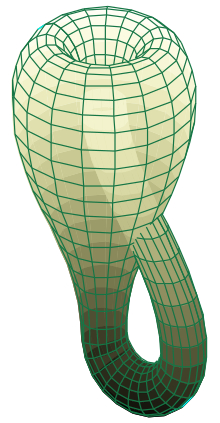
In mathematical areas such as topology , the differential topology , the Riemann geometry or function theory to areas not regarded more as objects that are embedded in the three-dimensional space, but is dispensed with the surrounding space and considers only the area for themselves. One speaks of abstract surfaces or of 2-manifolds.
motivation
Let be an open subset and a regular parameterization of a patch . One can now ask oneself which data one has to enter in order to make statements about . By definition, the derivative is an isomorphism . The length of tangential vectors can therefore be converted into a bilinear form
translate, the first fundamental form here , but in the general context called Riemannian metric . The Gramian determinant for is equal to the determinant of the representation matrix of , so the Riemannian metric already contains the information about areas and integrals . The second fundamental form and thus the main curvatures cannot be read off alone , as the following example of a cylinder shows:
For each is the standard scalar product , so the Riemannian metric cannot distinguish between a cylinder and a plane. But: The theorema egregium of Carl Friedrich Gauß states that the Gaussian curvature only depends on the Riemannian metric.
With this the Gaussian concept of curvature can be transferred to surfaces for which no embedding in Euclidean space is known or even only exists. An example is the hyperbolic plane , which has an obvious Riemannian metric with which it has constant negative curvature, but according to a theorem of David Hilbert has no isometric embedding in Euclidean space. (Isometric here means that the embedding induces the specified metric.)
Another phenomenon are surfaces like the real projective plane, which do not allow any embedding in Euclidean space, but only immersions (e.g. as Boyian surface ). You can embed them in higher-dimensional spaces, but since you are ultimately interested in properties that are independent of the embedding, it is advantageous to develop a language in which there are no more embeddings.
definition
In the field of topology, the term area is used as a synonym for 2-dimensional manifold. That is, a surface is a special topological space , a two-dimensional topological manifold . By definition, this is a Hausdorff space that is locally homeomorphic to . The local homeomorphisms are called maps and their entirety forms an atlas. Since the surface is locally homeomorphic to two-dimensional space , one defines that the dimension of the surface is just two. For example, a spherical surface is a surface in terms of topology.
A compact surface is also called closed when it is to be emphasized that it is a surface without a border. Bounded surfaces as special bounded manifolds are defined in the Generalizations section .
Examples
The simplest compact areas are
Further compact, orientable surfaces are obtained as a connected sum of g tori. (The connected sum of two surfaces is formed by cutting a 2-ball out of both surfaces and gluing the two 1-dimensional edge spheres.) The number g is the gender of the surface.
An explicit description of the area of gender g (as a smooth algebraic variety and especially a 2-dimensional manifold) is for example
- .
The Euler characteristic of the area of genus g is 2 - 2g .
The sphere has a spherical metric, the torus has flat metrics, the areas of gender at least 2 have hyperbolic metrics . The module space of hyperbolic metrics on a given area is called the Teichmüller space of the area.
Areas with additional structures
The surfaces listed above in the topology are the basic framework for the more specific surfaces that are examined in differential topology, Riemannian geometry or function theory. In these mathematical sub-areas, the area is equipped with an additional structure.
In the area of differential topology, the topological surface is additionally equipped with a differentiable structure in order to be able to differentiate functions that are defined on the surface and to be able to define the tangential plane. Since the area was defined without a surrounding space, in contrast to the previous section, the orientation of the area cannot be defined with the help of a normal vector . For this reason an (equivalent) definition by means of maps and tangent plane is chosen. The ability of a surface to orientate itself does not depend on the surrounding space.
In function theory, the surface is not supplemented by a differentiable structure, but by a complex structure . Such surfaces are called Riemann surfaces , and the complex structure makes it possible to define the concept of the holomorphic function on them . There are two different dimension terms in the area of Riemannian surfaces. On the one hand, it is again a special case of the topological surface and thus has dimension two; on the other hand, in function theory, one usually considers the complex number plane and understands the Riemannian surfaces as a generalization of this. In this context, the Riemann surface has the (complex) dimension one and is therefore also interpreted as a “complex curve”. Compact Riemann surfaces are projective algebraic curves , that is, they can be embedded in a complex projective space so that the image is described by polynomial equations.
A Riemannian metric can also be given on a differentiable surface , that is a scalar product on every tangential plane, which depends on the base point in a differentiable manner. Every regular area in the receives a Riemannian metric via the restriction of the standard scalar product. A Riemannian metric induces a conformal structure on orientable surfaces in which the length measurement is lost, but the information about angles is retained. The 90 ° rotation on the tangent spaces is an almost complex structure , and in the case of surfaces, every almost complex structure is a complex structure, i.e. every surface with a Riemannian metric is canonically a Riemannian surface.
classification
The classification theorem gives a list of surfaces such that each closed surface is homeomorphic to exactly one of them.
- An orientable surface is homeomorphic to the connected sum of tori . For it is the sphere, for the torus. The number is the gender of the surface.
- A non-orientable surface is homeomorphic to a connected sum of projective planes .
The same classification results for closed differentiable areas: each area is diffeomorphic to exactly one of the areas from the list. In general, the classifications of homotopy equivalence , homeomorphism , PL equivalence and diffeomorphism all agree for closed surfaces .
The classification does not apply to Riemannian surfaces: every Riemannian surface can be orientated and an orientable closed surface can carry significantly different complex structures.
- For gender 0 there is only one Riemann surface, the projective straight line or the Riemann number sphere .
- For gender 1, the Riemann surfaces (except for the choice of a base point) are elliptic curves and are classified by their j-invariant .
- For gender , the Riemann surfaces are parameterized by the Teichmüller space , which is itself a -dimensional complex manifold .
The uniformity theorem states that there are only three possibilities for the (not necessarily compact) universal superposition of a Riemann surface (according to the distinction ):
- the Riemann number ball
- the complex number plane
- the upper half plane
Closed surfaces with Riemannian metrics are too complicated for classification. Simply connected surfaces with constant curvature, which are not necessarily compact but complete, can, however, be classified: By scaling one can limit oneself to the curvatures . Then there is only one such area with the exception of isometry:
- : the unitary sphere
- : the Euclidean plane
- : the hyperbolic plane
This statement applies analogously to any dimensions. According to a theorem of Jacques Hadamard , every simply connected complete surface is not necessarily constant, but everywhere non-positive curvature is diffeomorphic to the plane.
Generalizations
- If you add the half-plane as a model to the definition of topological or differentiable surfaces , you get the concept of a surface with a border. Points of the surface that are mapped onto the straight line are called edge points. The closed unit disk in the plane is, for example, a differentiable surface with a border, the closed unit square is a topological surface with a border.
- Subsets of that have similar differentiability properties as regular surfaces are called submanifolds . Submanifolds of the dimension are called hypersurfaces .
- Higher-dimensional analogues of abstract surfaces are topological manifolds and differentiable manifolds .
- Higher-dimensional analogues of the Riemann surfaces are complex manifolds . Complex manifolds of dimension 2 are called complex surfaces. They are four-dimensional real manifolds.
literature
- Surfaces in space
- Ethan D. Bloch: A First Course in Geometric Topology and Differential Geometry. Birkhäuser, Boston 1997.
- Wilhelm Klingenberg: A Course in Differential Geometry. Springer, New York 1978.
- Abstract surfaces with Riemannian metrics
- Manfredo Perdigão do Carmo: Riemannian Geometry. Birkhäuser, Boston 1992, ISBN 0-8176-3490-8 .
- Riemann surfaces
- Hershel M. Farkas, Irwin Kra: Riemann Surfaces. Springer, New York 1980.
- Classification of topological surfaces
- William S. Massey: Algebraic Topology: An Introduction. Springer, Berlin 1967, ISBN 3-540-90271-6 .
- Classification of differentiable areas
- Morris W. Hirsch: Differential Topology. Springer, New York 1976, ISBN 0-387-90148-5 .
Web links
Individual evidence
- ↑ Klingenberg, Chapters 3.7 and 4.4
- ↑ Detlef Laugwitz: Differentialgeometrie , Teubner, 1960, p. 51.
- ^ W. Kühnel: Differentialgeometrie , Vieweg-Verlag, 2003, ISBN 3 528 17289 4 , p. 57
- ↑ David Hilbert, On Areas of Constant Gaussian Curvature, Transactions of the American Mathematical Society, Vol. 2, No. 1 (Jan., 1901), pp. 87-99



















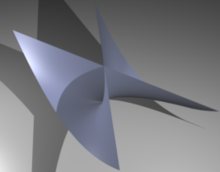
![f \ in \ mathbb {R} [x, y, z]](https://wikimedia.org/api/rest_v1/media/math/render/svg/cb09836918cd4b18a3ea73b98453bb13964e9a88)







































































